Gas chromatography-mass spectrometry study of the root and herb of Smallanthus sonchifolius
Authors:
Olga V. Demeshko 1; Elena V. Krivoruchko 1; Victoria A. Samoilova 1; Svetlana V. Romanova 2
Authors‘ workplace:
National University of Pharmacy, Department of Pharmacognosy
1; National University of Pharmacy, Department of Botany
2
Published in:
Čes. slov. Farm., 2018; 67, 160-163
Category:
Short News
Overview
Smallanthus sonchifolius (yacon) is a new prospective plant cultivated in Europe as a natural sugarcane substitute. It is used for diabetes and for the prevention of obesity. The study of carboxylic acids in the roots and herb of S. sonchifolius was carried out for the first time by gas chromatography-mass spectrometry (GC-MS). As a result of the study, 12 components were found in the roots of S. sonchifolius, 9 of which were carboxylic acids. The S. sonchifolius herb contained 41 components, 18 of which were carboxylic acids. The dominant compounds in the roots were: undecanoic acid, methyl ester – 546.04 mg/kg; 1-benzazirene-1-carboxylic acid, 2,2,5a-trimethyl-1a-[3-oxo-1-butenyl] perhydro-, methyl ester – 360.63 mg/kg; 9-octadecenoic acid (Z)-, methyl ester – 119.21 mg/kg. In the herb of the yacon dominant is cyclohexanol, 1-ethynyl – 28.67 mg/kg.
Key words:
Smallanthus sonchifolius (yacon) • carbo - xylic acids • GC-MS
Introduction
Сarboxylic acids have various pharmacological effects and play a significant role in the human body. Especially polyunsaturated acids with several double bonds are important. Into this group, octadecadienoic, octadecatrienoic and arachidonic can be included. They are often called essential fatty acids. They have the greatest biological activity, they participate in the transfer and exchange of cholesterol, the synthesis of prostaglandins and other vital substances, maintain the structure of cell membranes, are necessary for the work of the visual apparatus and nervous system, and increase immunity. The absence of these acids in food inhibits growth, inhibits reproductive function, leads to the development of atherosclerosis1). Octadecadienoic and octadecatrienoic acids cannot be synthesized by the human body itself and should be received with food. Expanding the resource base of natural sources of biologically active substances, improving the quality of life and enriching the diet is relevant in the modern world. One of the most promising plants is Smallanthus sonchifolius, which has been introduced into the culture in many countries of the world2–4).
S. sonchifolius (yacon) is a herbaceous, perennial plant of the genus Smallanthus (Polymnia) of the Asteraceae family. The native land of the yacon (a relative of Helianthus annuus and Helianthus tuberosus) are the highlands of the Andes of Central and Western America. The plant is cultivated in Europe2–4). Recently, scientists from different countries are exploring hypoglycemic5–9), antioxidant10) and prebiotic11) properties of the yacon and treatment of atherosclerosis12). It is used as a substitute for cane sugar in diabetes and for the prevention of obesity, and it improves the immune system13). To continue the complex study of the yacon biologically active substances, it is expedient to study the qualitative and quantitative content of carboxylic acids in the roots and herb.
Experimental part
Plant materials
The objects of the research were the roots and herbs of yacon harvested at the end of the growing season in the Kharkiv region, in the Merefa region, in the experimental farm of the Ukrainian Academy of Agrarian Sciences in 2017.
Preparation of extracts
The analysis of methyl ethers of carboxylic acids was carried out by the method of GC-MS 14–16) on a 5973N/6890N MSD/DS Agilent Technologies (USA). The internal standard (solution of tridecane (0.25 µg) in hexane) and 1.0 ml of the methylating agent (14% BCL3 in methanol, Supelco 3-3033) were added to the dry shredded plant raw material (0.25 µg) in a vial of 2.0 ml. The mixture was held at 65 °С in a sealed vial for 8 hours. Within this time organic acids were completely extracted from the plant material and hydrolysis and methylation of fatty acids occured. Free organic and phenolcarboxylic acids were ethylated simultaneously. The reaction mixture was elutriated from the plant material and diluted with 1.0 ml of distilled water. Methyl ethers were extracted with 0.2 ml of the methylene chloride, carefully shaken up several times within an hour and the obtained extract was chromatographed17–18).
Chromatographic conditions
Sample introduction (2.0 µl) was carried out into a chromatographic column in the splitless mode without the split ratio within 0.2 minute. A capillary column HP-INNOWAX (30 m × 250 µm × 0.50 µm) was used for separation. The mobile phase: helium, gas flow rate: 1.2 ml/min. Temperature of the sample injections heater: 250 °С. Temperature of furnace is programmable from 50 to 320 °С with the rate of 4 degree/min. For component identification the data from the mass-spectra libraries NIST05 and WILEY 2007 with the total number of spectra of more than 470000 were used combined with identification programs AMDIS and NIST.
For quantitative calculations, the internal standard method was used. Calculation of components content C (mg/kg) was carried out using the formula:
C = P1.0.25 × 1000 / P2.m,
where: P1 – peak area of the tested substance, P2 – peak area of the standard, 0.25 – mass of the internal standard (µg) injected into the sample; m – sample mass (g).
The relative content of carboxylic acids was determined once in % of their sums.
The results of the research are presented in Figs. 1, 2 and Tables 1, 2.
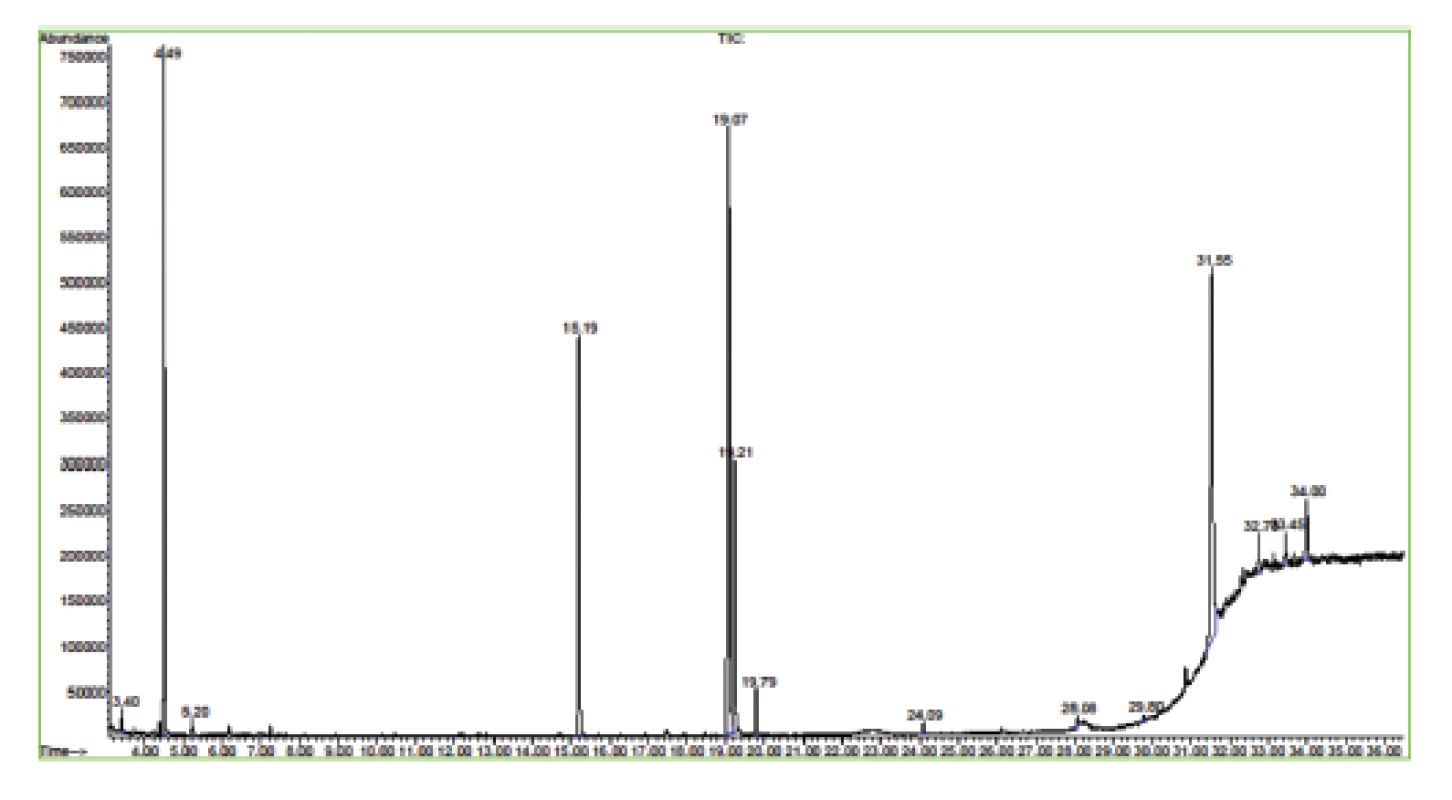
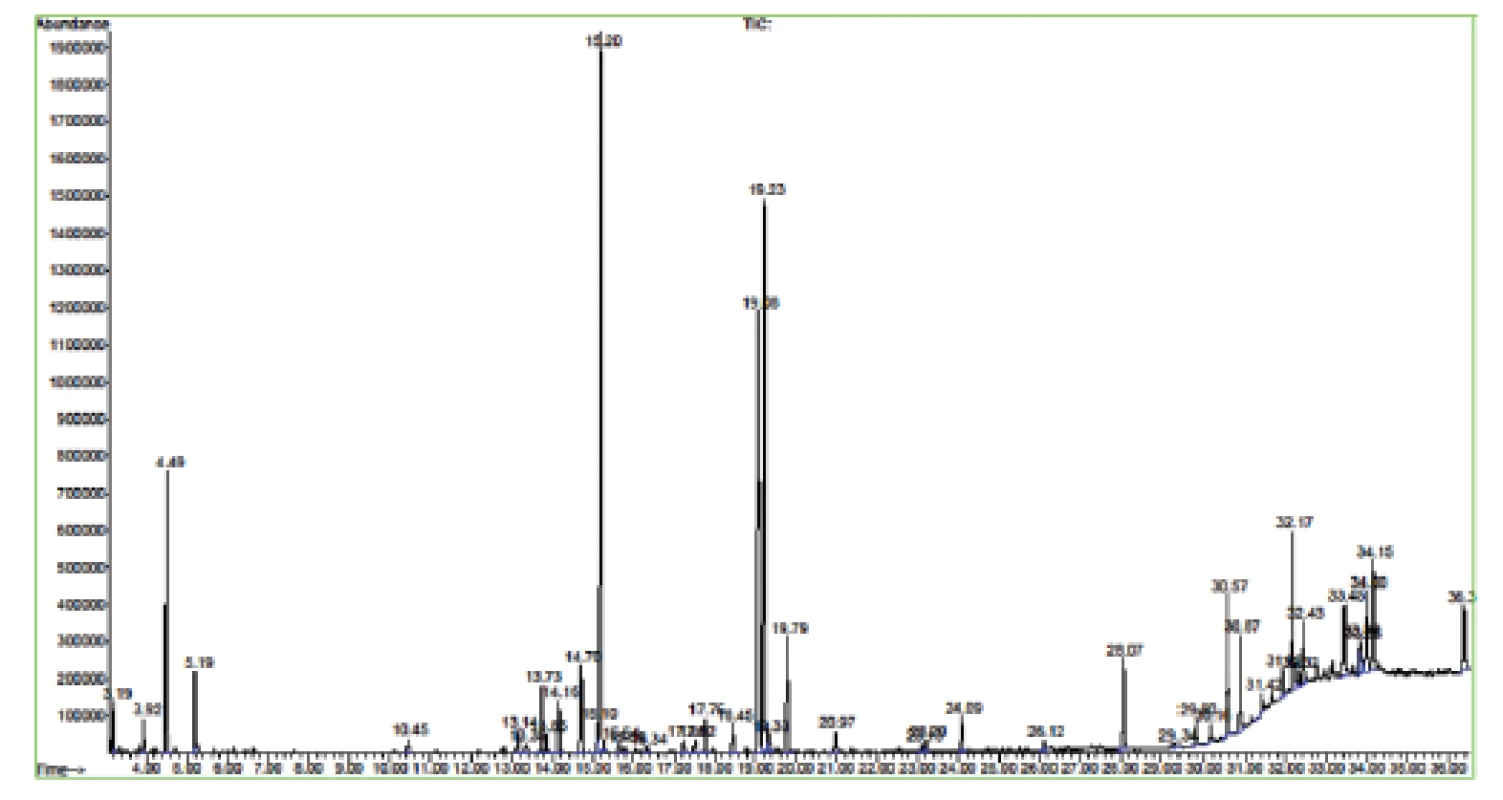
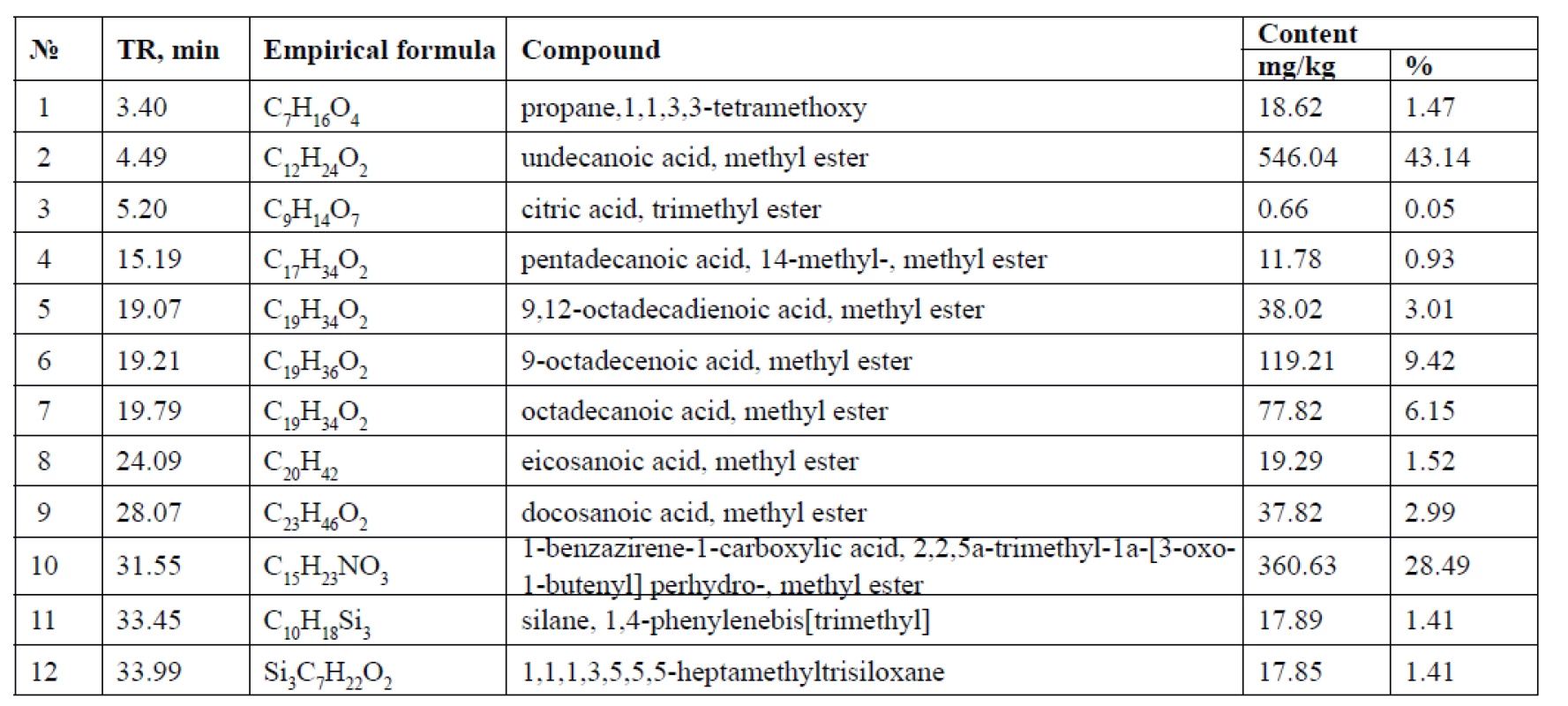
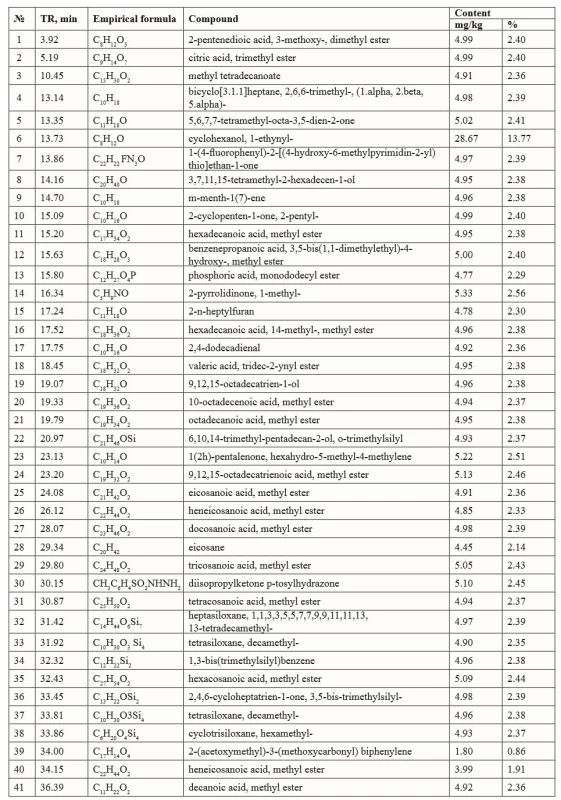
Results and discussion
The study of carboxylic acids in the roots and herbs of S. sonchifolius was carried out for the first time by gas chromatography-mass spectrometry. As a result of the study, 12 components were found in the roots of S. sonchifolius, 9 of which were carboxylic acids. The S. sonchifolius herb contains 41 components, 18 of which are carboxylic acids. The dominant compounds in the roots are: undecanoic acid, methyl ester – 546.04 mg/kg; 1-benzazirene-1-carboxylic acid, 2,2,5a-trimethyl-1a-[3--oxo-1-butenyl]perhydro-, methyl ester – 360.63 mg/kg; 9-octadecenoic acid, methyl ester – 119.21 mg/kg. In the herb of the yacon dominant is the: cyclohexanol, 1-ethynyl – 28.67 mg/kg. The roots and herbs of S. sonchifolius are a promising raw material for further phytochemical and pharmacological research.
Conflicts of interest: none.
Received July 25, 2018 / Accepted September 11, 2018
Ass. Prof. Olga V. Demeshko, PhD (✉) • E. V. Krivoruchko • V. A. Samoilova
National University of Pharmacy, Department of Pharmacognosy
str. Valentinovska 4, 61168 Kharkiv, Ukraine
e-mail: olgademeshko@gmail.com
S. V. Romanova
National University of Pharmacy, Department of Botany
Sources
1. Isaev J. I., Mykchailenko О. О., Kovalyov V. M., Gurbanov G. M., Suleymanov M. Y. Gas chromatography-mass spectrometry studies of the component composition of carboxylic acids of the rhizomes of Iris medwedewii and Iris carthaliniae (Iridaceae). Ces. Slov. Farm. 2017; 66(1), 9–14.
2. Sousa S., Pinto J., Rodrigues C., Gião M., Pereira C., Tavaria F., Malcata F. X., Gomes A., Pacheco M. T. B., Pintado M. Antioxidant properties of sterilized yacon (Smallanthus sonchifolius) tuber flour. Food Chemistry 2015; 188, 504–509.
3. Mischenko L. T. Introduction of a new medicinal plant in Ukraine. Bulletin of Agrarian Science 2012; 8, 45–48.
4. Mischenko L. T. New vegetable and medicinal crop in Ukraine. Scientific Bulletin of the National University of Bioresources and Nature Management 2012; 180, 250–256 (Series: Agronomy).
5. Ahmad Faris A. I., Dani Sugeng P., Arifah M., Nurcesuma A., Nabaatin I. Effectiveness of Yakon (Smallanthus Sonchifolius) Leaves Steeping as Insulin Subtitute for Diabetes Mellitus in Streptozotocin-Induced Diabetic Rats. International Journal of Health and Economic Development 2016; 2(1), 29–39.
6. Miura T. Antidiabetic activity of Fuscoporia oblique and Smallanthus sonchifolius in genetically tyre 2 diabetic mice. Journal of Traditional Medicines (Japan) 2007; 24(2), 47–50.
7. Baroni S., Suzuki-Kemmelmeier F., Caparroz-Assef S. M., Cuman R. K. N., Bersani-Amado C. A. Effect of crude extracts of leaves of Smallanthus sonchifolius (yacon) on glycemia in diabetic rats. Braz. J. Pharm. Sci. 2008; 44(3), 521–530.
8. Dou D. Q., Kang T. G., Qiu Y.K., Tian F. Studies on the Anti-diabetic Constituents of the Leaves of Smallanthus sonchifolius (Yacon). Planta Med. 2008; 74, 71.
9. Baroni S., da Rocha B. A., Oliveira de Melo J., Comar J. F., Caparroz-Assef S. M., Bersani-Amado C. A. Hydroethanolic extract of Smallanthus sonchifolius leaves improves hyperglycemia of streptozotocin induced neonatal diabetic rats. Asian Pac. J. Trop. Med. 2016; 9(5), 432–436.
10. Sousa S., Pinto J., Rodrigues C., Gião M., Pereira C., Tavaria F., Malcata F. X., Gomes A., Bertoldo Pacheco M. T., Pintado M. Antioxidant properties of sterilized yacon (Smallanthus sonchifolius) tuber flour. Food Chem. 2015; 188, 504–509.
11. Sousa S., Pinto J., Pereira С., Malcata F. X., Bertoldo Pacheco M. T., Gomes A. M., Pintado M. In vitro evaluation of yacon (Smallanthus sonchifolius) tuber flour prebiotic potential. Food and Bioproducts Processing 2015; 95, 96–105.
12. Mensink R. P., Zock P. L., Kester A. D., Katan M. B. Effects of dietary fatty acids and carbohydrates on the ratio of serum total to HDL cholesterol and on serum lipids and apolipoproteins: a meta-analysis of 60 controlled trials. Am. J. Clin. Nutr. 2003; 77(5), 1146–1155.
13. Choque Delgado G. T., Thomé R., Gabriel D. L., Tamashiro W. M. S. C., Pastore G. M. Yacon (Smallanthus sonchifolius)-derived fructooligosaccharides improves the immune parameters in the mous. Nutrition Research 2012; 32(11), 884–892.
14. NIST Mass Spec Data Center SES. 2005a. Mass Spectra, 6th edn. National Institute of Standards and Technology: Gaithersburg MD.
15. NIST Mass Spec Data Center SES. 2005b. Retention Indices, 6th edn.
16. State Pharmacopoeia of Ukraine. In 3 vols. 2nd ed. Kharkov: SE «Ukrainian scientific pharmacopoeial center of medicines quality». 2015; 1 (in Ukrainian).
17. Carrapiso A. I., Garcia C. Development in lipid analysis: some new extraction techniques and in situ transesterification. Lipids 2000; 35(11), 1167–1177.
18. Bicchi C., Brunelli C., Cordero C., Rubiolo P. Galli M., Sironi A. Direct resistively heated column gas chromatography (Ultrafast module-GC) for high-speed analysis of essential oils of differing complexities. J. Chromatogr. A. 2004; 1024(1–2), 195–207.
Labels
Pharmacy Clinical pharmacologyArticle was published in
Czech and Slovak Pharmacy
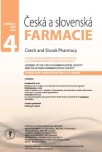
2018 Issue 4
Most read in this issue
- Biological role of copper as an essential trace element in the human organism
- Gas chromatography-mass spectrometry study of the root and herb of Smallanthus sonchifolius
- Study of influence of 1,3-oxazole-4-yl-phosphonic acid derivative on nitric oxide system indicators in rats with arterial hypertension
